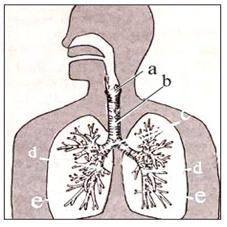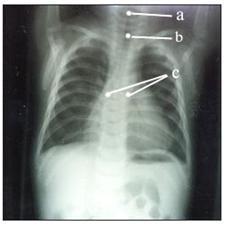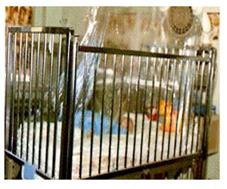급성 후두 기관 기관지염으로 생긴 크루프 Croup caused by acute laryngotracheobronchitis
| 급성 후두 기관 기관지염으로 생긴 크루프의 원인 |

그림 84. a-후두, b-기관, c-기관지, d-세기관지, e-폐 후두, 기관, 기관지에 생긴 감염병을 후두 기관 기관지염이라 한다. 이 병이 있을 때 크루프가 생길 수 있다.
출처-소아가정의학백과

사진 85. 유아 가슴과 폐 X-선 사진.
a-후두, b-기관, c-기관지.
Copyrightⓒ 2011 John Sangwon Lee, MD., FAAP
- 바이러스가 후두에만 감염되면 급성 바이러스 후두염이 생길 수 있고, 급성 바이러스 후두염(급성 후두염)으로 크루프가 생길 수 있다.
- 실제로 급성 바이러스 후두염을 일으킨 바이러스는 후두에만 감염되어 급성 후두염만 일으키는 경우는 드물다.
- 후두의 바로 위에 연결되어 있는 인두에도 감염되어 급성 바이러스 인두염, 후두의 바로 아래에 연결되어 있는 기관까지 감염되어 급성 바이러스 기관염을 일으키고, 더 아래로 급성 기관지염, 더 위로는 급성 비염이 동시 생길 수 있다.
- 후두, 기관, 기관지에 주로 감염되어 생긴 급성 바이러스 감염병을 급성 후두 기관 기관지염이라 하고 그로 인해 크루프가 생길 수 있다.
- 급성 후두 기관 기관지염에 의한 크루프의 주원인은 역시 바이러스 감염이다.
- 급성 바이러스 후두염에 의한 크루프와 급성 후두 기관 기관지염에 의한 크루프는 정확히 감별하기가 때로는 어렵다.
- 그래서 임상에서 어떤 때는 두 병을 같은 병으로 취급할 때가 많다.
급성 바이러스 후두염에 의한 크루프 Croup caused by acute viral laryngitis
| 급성 후두 기관 기관지염으로 생긴 크루프의 증상 징후 |
- 이 병의 증상 징후는 나이, 바이러스의 종류, 그 바이러스가 신체 다른 부위에 감염되어 일으킨 감염병의 유무 등에 따라 다르다.
- 급성 후두 기관 기관지염으로 생긴 크루프는 감기나 바이러스 인두염 등 바이러스 상기도 감염과 동시 생기는 것이 보통이다.
- 인두는 아래로 후두와 연결되고, 후두는 아래로 기관에 연결되어 있으며, 인두에서 기관지까지의 거리가 대단히 짧기 때문에 맨 처음 바이러스가 인두, 후두, 기관 중 한 부분에만 감염됐다가 조금 지난 후에는 상·하기도 전체에 감염되어 인두, 후두, 기관, 기관지 등, 상·하기도 전체에 동시 감염 될 때가 많다. 특히 영유아들에게는 더 그렇다.
- 특히 영유아들은 바이러스 감염이나 박테리아 감염에 대한 저항력이 약하고 상·하기도가 가늘고 아주 짧기 때문에 인두염, 후두염, 기관염, 기관지염이 동시 함께 생기기 쉽다.
- 그에 따라 인두염, 후두염, 기관염, 기관지염의 증상 징후가 한 번에 다 나타날 수 있다.
- 열과 콧물이 나며 목안과 전신이 아플 수 있다.
- 물개가 짖는 소리와 비슷한 소리로 컹컹 기침을 하고 흡기 협착음이 날 수 있다.
- 급성 후두 기관 기관지염으로 생긴 크루프는 밤에 자다가 깨서 기침을 컹컹하면서 목이 쉰 소리를 낼 수 있다.
- 숨결이 빠르고 호흡곤란도 생길 수 있다.
- 특히 흡기 호흡곤란이 잘 생긴다.
- 드물게 급성 박테리아 후두개염을 앓을 때와 같이 크루프가 생긴 얼굴이 창백해지고 파랗게 질리기도 한다.
- 이 병을 앓는 아이들의 대부분의 경우, 턱 바로 밑 중앙에 있는 목의 앞 부위 즉, 후두가 있는 부위가 아프다고 호소하기도 한다.
- 밥맛이 떨어지고 몹시 보채고, 숨을 제대로 쉬지 못하기 때문에 안절부절 못할 수 있다.
| 급성 후두 기관 기관지염으로 생긴 크루프의 진단 |
- 병력, 증상 징후, 진찰소견 등을 종합하여 이 병을 쉽게 진단할 수 있다.
- 목과 흉부 X-선 사진, 목 초음파 검사, 피검사, 인두 점막에서 점액 피검물로 세균배양검사 등을 해서 다른 인두염 등과 감별 진단할 수 있다.
| 급성 후두 기관 기관지염으로 생긴 크루프의 감별 진단 |
① 후두 내 이물이나 기관 내 이물로 크루프가 생길 수 있다.
② 급성 후두 기관 기관지염으로 생긴 크루프의 증상 징후와 기도 내 이물로 생긴 크루프의 증상 징후가 비슷할 때가 있다. 이 두 종류의 크루프를 감별 진단해야 한다.
③ 급성 후두개염으로 생긴 크루프
④ 기관 주위 감염병으로 생긴 크루프
⑤ 인두 후부 농양으로 생긴 크루프
⑥ 편도 주위 농양으로 생긴 크루프
⑦ 급성 후두 기관 기관지염으로 생긴 크루프 등을 서로 감별 진단해야 한다.
| 급성 후두 기관 기관지염으로 생긴 크루프의 치료 |

사진 86. 크루프로 인해 호흡곤란이 생기면 산소호흡치료를 산소텐트 속에서 할 수 있다.
Copyright ⓒ 2011 John Sangwon Lee, MD., FAAP
- 이 병의 진행 과정, 중증도, 증상 징후, 합병증의 유무 등에 따라 병원 입원 치료를 하거나 의사의 지시에 따라 집에서 치료할 수 있다.
- 급성 바이러스 후두염으로 생긴 크루프의 치료와 거의 비슷하게 치료한다.
- 바이러스가 이 병의 원인이기 때문에 항생제 치료는 이 병에 효력이 없다.
- 항히스타민제나 기침 치료약도 이 병에 별 효력이 없다.
- 코데인이나 하이코민 등 강력한 기침 치료약은 그 병을 근본적으로 치료할 수도 없고 뇌에 있는 기침 중추의 기능을 둔화시켜서 기침을 못하게 하는 약리 작용이 있으므로 쓰지 않는 것이 좋다.
- 알부테롤 분무나 시럽, 알약 또는 흡입용 분말 MDI 등으로 대증치료를 할 수 있다.
- 그리고 프레드니손 제나 다른 종류의 경구용 코르티코스테로이드제로, 또는 코르티코스테로이드제 분무로 3~5일간 치료할 수 있다.
- 탈수는 수분을 충분히 섭취하거나 포도당 전해질용액 정맥주사로 수화 치료한다.
- 방안의 습도를 보통 때보다 약간 높여 기침할 때 가래를 쉽게 뱉도록 한다.
- 기관 속이나 기관지 속에 가래가 있을 때 그 가래를 뱉어내려고 기침을 한다.
- 크루프를 앓는 동안 가래를 쉽게 뱉어낼 수 있는 이상적인 기침 치료약은 없다.
- 알부테롤은 기관지를 확장시킬 수 있는 기관지 확장제이고 코르티코스테로이드제는 기관지 등 기도에 생긴 염증을 소염시키는 항 염증제이다.
- 이 두 종류의 약 중 한 가지만 또는 두 가지로 치료할 때 바로 그런 약물이 기침치료약 역할을 할 수 있다.
- 참고로 이런 약물 치료에 관해서 찬반론이 있다.
- 이 병을 적절히 잘 치료해 주면 약 4~7일 정도 되면 잘 낫는다.
Croup caused by acute laryngotracheobronchitis 급성 후두 기관 기관지염으로 생긴 크루프
Causes of Croup from Acute Laryngeal Bronchitis

Figure 84. Infectious diseases in the a-larynx, b-trachea, c-bronchi, d-bronchiole, e-pulmonary larynx, trachea and bronchi are called laryngeal bronchitis.
Croup can develop when you have this disease. Source-Pediatric Family Medicine Encyclopedia

Picture 85. X-ray of infant chest and lungs. a-larynx, b-trachea, c-bronchi. Copyrightⓒ 2011 John Sangwon Lee, MD., FAAP
• If the virus only infects the larynx, acute viral laryngitis can occur, and acute viral laryngitis (acute laryngitis) can lead to croup.
• In fact, the virus that caused acute viral laryngitis rarely only infects the larynx and causes only acute laryngitis.
• Acute viral pharyngitis, an organ connected directly below the larynx, can also be infected with the pharynx, resulting in acute viral tracheitis, acute bronchitis further down, and acute rhinitis higher up.
• Acute viral infections caused by infections of the larynx, trachea and bronchi are called acute laryngeal bronchitis and can cause croup.
• The main cause of croup from acute laryngeal bronchitis is also a viral infection.
• It is sometimes difficult to accurately differentiate between acute viral laryngitis and acute laryngeal bronchitis.
• So, in clinical practice, sometimes two bottles are treated as the same bottle. Croup caused by acute viral laryngitis
Symptoms of Croup from Acute Laryngeal Bronchitis
• Symptoms and signs of this disease vary depending on the age, the type of virus, and the presence or absence of an infectious disease caused by the virus infecting other parts of the body.
• Croup caused by acute laryngeal bronchitis usually occurs concurrently with viral upper respiratory infections such as cold or viral pharyngitis.
• The pharynx is connected to the larynx downwards, the larynx is connected to the trachea downward, and the distance from the pharynx to the bronchi is very short, so the first time the virus is infected only in one of the pharynx, larynx, or trachea. In many cases, the entire upper and lower respiratory tract is infected, and the entire upper and lower respiratory tract, such as the pharynx, larynx, trachea, and bronchi, is often infected. Especially for infants and toddlers.
• In particular, infants and toddlers are less resistant to viral or bacterial infections, and their upper and lower respiratory tracts are thin and very short, so they are more likely to develop pharyngitis, laryngitis, tracheitis, and bronchitis at the same time.
• As a result, symptoms of pharyngitis, laryngitis, tracheitis, and bronchitis may appear all at once.
• A fever and runny nose may occur and sore throat and whole body. • You may cough and have an inhalation stricture with a sound similar to the sound of a seal barking.
• Croup, caused by acute laryngeal bronchitis, can woke up at night and cough up and make a hoarse throat.
• Breathing is fast and breathing difficulties may occur.
• Difficulty in breathing, especially inhalation, is common.
• Rarely, the crouped face becomes pale and blue, such as when suffering from acute bacterial epiglottis.
• Most children with this disease complain of pain in the front part of the neck, in the center of the lower chin, where the larynx is located.
• You may feel restless because the taste of the rice is poor, you feel very frustrated, and you cannot breathe properly.
Diagnosis of croup caused by acute laryngeal bronchitis
• You can easily diagnose this disease by synthesizing your medical history, symptoms, and examination findings.
• It can be diagnosed differently from other pharyngitis by performing an X-ray of the neck and chest, an ultrasound of the neck, a blood test, and a bacterial culture test using a mucous specimen from the pharyngeal mucosa.
Differential diagnosis of croup caused by acute laryngeal bronchitis
① A foreign body in the larynx or a foreign body in the trachea can cause a crout.
② Symptoms of Croup caused by acute laryngeal bronchitis may be similar to those of Croup caused by a foreign body in the airways. These two types of croup should be diagnosed differentially.
③ Croup caused by acute epiglottis infection
④ Croup caused by infectious diseases around the trachea
⑤ Croup from posterior pharyngeal abscess
⑥ Croup from an abscess around the tonsils
⑦ Acute laryngeal bronchitis caused by kruppe, etc. should be diagnosed differently from each other.
Treatment of croup caused by acute laryngeal bronchitis

Picture 86. If you have trouble breathing due to a croup, oxygen respiration treatment can be performed in an oxygen tent. Copyright ⓒ 2011 John Sangwon Lee, MD., FAAP
• Depending on the course of the disease, its severity, symptoms, symptoms, complications, etc., you can be treated in a hospital or at home according to your doctor’s instructions.
• Treated almost identically to the treatment of croup caused by acute viral laryngitis.
• Antibiotic treatment has no effect on the disease because the virus is the cause of the disease.
• Antihistamines or cough medicines have little effect on the disease.
• Strong cough remedies such as codeine and haicomin cannot fundamentally cure the disease, and they are not recommended because they have a pharmacological action that prevents coughing by slowing the function of the cough center in the brain.
• Symptomatic treatment can be performed with albuterol spray or syrup, pills, or MDI powder for inhalation.
• And it can be treated for 3 to 5 days with prednisone or other types of oral corticosteroids, or with a corticosteroid spray.
• Dehydration is treated with hydration by drinking enough fluids or intravenous injection of glucose electrolyte solution.
• Increase the humidity in the room slightly above normal to make it easier to spit out phlegm when coughing.
• Coughing to spit out phlegm when there is phlegm in the trachea or trachea.
• There is no ideal cough remedy that makes it easier to spit out sputum while suffering from croup.
• Albuterol is a bronchodilator that can expand the bronchi, and corticosteroids are anti-inflammatory drugs that reduce inflammation in the airways such as the bronchi.
• When treated with only one or both of these two types of drugs, the same drugs can act as cough medicines.
• For reference, there are pros and cons about these medications.
• If this disease is properly treated, it will heal well in about 4 to 7 days.
출처 및 참조 문헌 Sources and references
- NelsonTextbook of Pediatrics 22ND Ed
- The Harriet Lane Handbook 22ND Ed
- Growth and development of the children
- Red Book 32nd Ed 2021-2024
- Neonatal Resuscitation, American Academy Pediatrics
-
Childhood Emergencies in the Office, Hospital and Community, American Academy of Pediatrics
-
Emergency Medical Service for Children, By Ross Lab. May 1989. p.10
-
Emergency care, Harvey grant, and Robert Murray
-
Emergency Care Transportation of Sick and Injured American Academy of Orthopaedic Surgeons
-
Emergency Pediatrics A Guide to Ambulatory Care, Roger M. Barkin, Peter Rosen
-
Immediate care of the acutely ill and injured, Hugh E. Stephenson, Jr
-
The Critically Ill Child, Diagnosis and Management, Edited by Clement A. Smith
-
Emergency Medical Services for Children: The Role of the Primary Care Provider, America Academy of Pediatrics
-
Quick Reference To Pediatric Emergencies, Delmer J. Pascoe, M.D., Moses Grossman, M.D. with 26 contributors
-
Manual of Emergency Care
-
응급환자관리 정담미디어
-
소아가정간호백과–부모도 반의사가 되어야 한다, 이상원
-
Neonatal Resuscitation American heart Association
-
Neonatology Jeffrey J.Pomerance, C. Joan Richardson
-
Pediatric Resuscitation Pediatric Clinics of North America, Stephen M. Schexnayder, M.D.
-
Pediatric Critical Care, Pediatric Clinics of North America, James P. Orlowski, M.D.
-
Preparation for Birth. Beverly Savage and Dianna Smith
-
Nelson Textbook of Pediatrics 14th ed. Beherman,
-
The Johns Hopkins Hospital, The Harriet Lane Handbook, 18th edition
-
Red book 29th edition 2012
-
Nelson Text Book of Pediatrics 19th Edition
-
Infectious disease of children, Saul Krugman, Samuel L Katz, Ann A. Gershon, Catherine Wilfert
-
The Harriet Lane Handbook 19th Edition
-
소아과학 대한교과서
-
제1권 소아청소년 응급의료 참조문헌과 출처
-
Other
Copyright ⓒ 2015 John Sangwon Lee, MD., FAAP
“부모도 반의사가 되어야 한다”-내용은 여러분들의 의사로부터 얻은 정보와 진료를 대신할 수 없습니다.
“The information contained in this publication should not be used as a substitute for the medical care and advice of your doctor. There may be variations in treatment that your doctor may recommend based on individual facts and circumstances. “Parental education is the best medicine.”